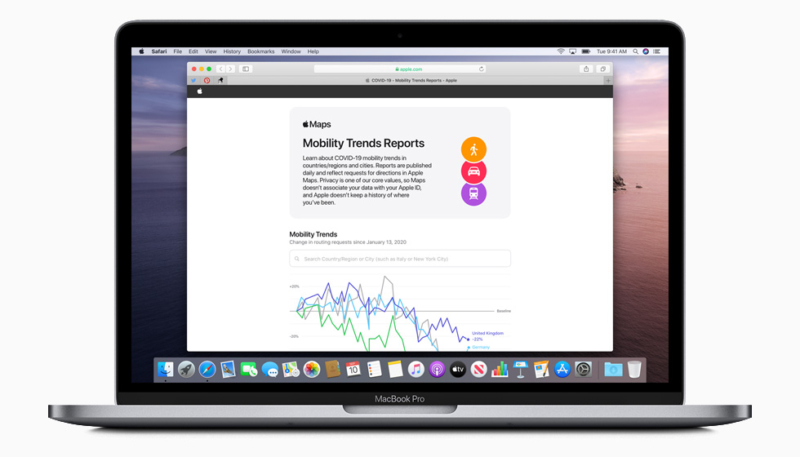Apple today announced the release of a new mobility data trends tool using Apple Maps data in an effort to mitigate the spread of COVID-19 coronavirus by providing “helpful insights to local governments and health authorities.”
Apple says the data could act as a foundation for new public policies by showing changes in the volume of people driving, walking, or taking public transit. The new website uses aggregated data collected from Apple Maps and indicates mobility trends for major cities and 63 countries or regions. The information is generated by counting the number of requests made to Apple Maps for directions.
The data sets are compared to reflect a change in the volume of people driving, walking or taking public transit around the world. Data availability in a particular city, country, or region is subject to a number of factors, including minimum thresholds for direction requests made per day. Users can search by city, country, or region to see how routing requests have shifted since January 13, 2020, leading up to today. Apple also provides a complete downloadable data set that features daily changes in requests for directions by transportation type for all available countries and cities.
Apple says Apple Maps does not associate mobility data with a user’s Apple ID, and Apple does not keep a history of where a user has been. Data collected by Maps, such as search terms, navigation routing, and traffic information is associated with random, rotating identifiers that continually reset, preventing a profile of movements and searches from being built.
In the announcement, Apple also shared some of its other efforts to aid in the fight against COVID-19. The Cupertino firm has sourced and donated well over 20 million face masks for medical professionals on the front lines around the world. Apple is working with its suppliers to design and produce face shields and is shipping 1 million face masks per week to the areas that need them most.
Apple helped Stanford Medicine build a new app for first responders (police, firefighters and paramedics), to help screen their symptoms and, if needed, schedule a testing appointment.
Siri Audio Briefs for COVID-19 help customers receive the latest news and information about the pandemic through short podcasts from trusted news providers and Siri can also provide guidance and resources from the CDC if asked, “How do I know if I have coronavirus?”
In Apple Maps, grocery, food delivery, and medical services are prioritized when searching nearby, and a curated collection of telehealth apps are available on the App Store. Apple is also providing content and services to parents, teachers and IT teams to help with the transition to virtual learning, including one-on-one training and numerous online resources.
Apple recently launched a joint effort with Google to enable the use of Bluetooth technology to help governments and health agencies reduce the spread of the virus, with user privacy and security central to the design. Apple also released a new screening tool and set of resources to help people stay informed and take the proper steps to protect their health during the spread of COVID-19, based on the latest CDC guidance. For more information visit apple.com/covid19.


